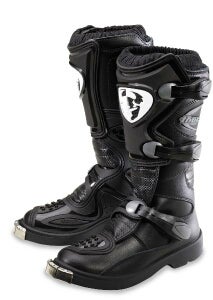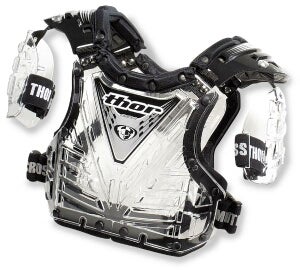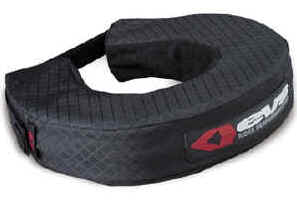Riding Boots
 Contrary to
what some tracks will actually allow, motocross style riding boots
should be considered a must. Not hiking boots, but proper MX riding
boots. The primary reason for even a basic over-the-ankle boot on a
young ATV pilot is to protect the foot and ankle from sprains
caused by either falling from the machine or more likely,
unintentionally dropping a foot in front of a rear tire. This issue
is a real concern for recreational novices who may want to
instinctively drop a foot down for balance, or when landing a jump
with the foot not properly placed on the footpegs, or even while
bouncing over rough terrain. An MX boot will not stop this
possibility, but the injury will be minimal if any at all since the
boot not only protects the ankle from hyper-rotation but protects
the entire shin area as well.
A decent
entry level boot such as the Thor or Alpinestar can be had for as
little as $100. If cost is an issue, then many racing circuits and
clubs have boot exchange programs- you can either buy a set of used
boots, or trade in your old ones as your child grows out of them.
An alternate source can be online internet-based
auctions.
Contrary to
what some tracks will actually allow, motocross style riding boots
should be considered a must. Not hiking boots, but proper MX riding
boots. The primary reason for even a basic over-the-ankle boot on a
young ATV pilot is to protect the foot and ankle from sprains
caused by either falling from the machine or more likely,
unintentionally dropping a foot in front of a rear tire. This issue
is a real concern for recreational novices who may want to
instinctively drop a foot down for balance, or when landing a jump
with the foot not properly placed on the footpegs, or even while
bouncing over rough terrain. An MX boot will not stop this
possibility, but the injury will be minimal if any at all since the
boot not only protects the ankle from hyper-rotation but protects
the entire shin area as well.
A decent
entry level boot such as the Thor or Alpinestar can be had for as
little as $100. If cost is an issue, then many racing circuits and
clubs have boot exchange programs- you can either buy a set of used
boots, or trade in your old ones as your child grows out of them.
An alternate source can be online internet-based
auctions.
Chest Protectors
 When it comes
to keeping your kids safe while riding, there's almost no way to
err on the side of too cautious when it comes to gear (except maybe
covering the kid with multiple layers of bubble wrap). An optional
piece of equipment that's worthy of consideration is a chest
protector which is a plastic vest that slips on over the shoulders
much like shoulder pads of a football player. For the big guys the
chest protector provides an effective barrier to roost when closely
following a machine. A nickel size rock flung at your chest at a
combined speed of 50 mph can be enough to send you off the track or
trail writhing in pain. This is not as big an issue for mini quads
since the speeds are much lower, however there are still quite a
few reasons to consider one.
A chest
protector is designed in a way to dissipate blunt blows to the
chest, shoulders, back, and elbows. This can be the saving grace
for a young rider who comes down hard front end first on a jump and
smashes his chest against the handlebars, or falls off his ATV on
his back and lands on a rock, tree root, or his own quad. The force
of the impact is spread out along the chest and the risk of a
contusion is greatly minimized.
Additionally, there's the coolness factor along with a
convenient place to put a racer's name and number. Chest protectors
such as the Thor Minishock or Microshock are usually available for
60 or 70 dollars from all of your aftermarket suppliers.
When it comes
to keeping your kids safe while riding, there's almost no way to
err on the side of too cautious when it comes to gear (except maybe
covering the kid with multiple layers of bubble wrap). An optional
piece of equipment that's worthy of consideration is a chest
protector which is a plastic vest that slips on over the shoulders
much like shoulder pads of a football player. For the big guys the
chest protector provides an effective barrier to roost when closely
following a machine. A nickel size rock flung at your chest at a
combined speed of 50 mph can be enough to send you off the track or
trail writhing in pain. This is not as big an issue for mini quads
since the speeds are much lower, however there are still quite a
few reasons to consider one.
A chest
protector is designed in a way to dissipate blunt blows to the
chest, shoulders, back, and elbows. This can be the saving grace
for a young rider who comes down hard front end first on a jump and
smashes his chest against the handlebars, or falls off his ATV on
his back and lands on a rock, tree root, or his own quad. The force
of the impact is spread out along the chest and the risk of a
contusion is greatly minimized.
Additionally, there's the coolness factor along with a
convenient place to put a racer's name and number. Chest protectors
such as the Thor Minishock or Microshock are usually available for
60 or 70 dollars from all of your aftermarket suppliers.
Neck Brace
Neck braces are become more and more popular in
youth ATV racing probably due to the fact that proportionately
speaking kids' helmets are pretty large and their neck muscles have
to work overtime to support that sizeable extra weight on their
heads. For comparison's sake, consider this: a youth helmet on a
75lb child's head would feel the same for a 200lb adult wearing a
helmet that weighs nearly 2-1/2 times its normal weight. No thanks.
A neck brace can reduce fatigue by providing support to the helmet
from bobbing side to side and front to back (like you can see some
kids do through whoop sections).
 But
the real advantage is injury protection in the event of a fall or
sudden jolt. Not only is the neck protected by virtue of limiting
the maximum articulation of the neck, but the collar bone is also
protected. Research done by EVS indicates that most common neck and
collarbone injuries occur when the chin touches the chest. By
surrounding the neck brace around the front the neck, the
likelihood of this type of injury is greatly reduced.
These braces run about $30- well worth the money
considering the protective value.
But
the real advantage is injury protection in the event of a fall or
sudden jolt. Not only is the neck protected by virtue of limiting
the maximum articulation of the neck, but the collar bone is also
protected. Research done by EVS indicates that most common neck and
collarbone injuries occur when the chin touches the chest. By
surrounding the neck brace around the front the neck, the
likelihood of this type of injury is greatly reduced.
These braces run about $30- well worth the money
considering the protective value.
| • Contact Information |


 Your Privacy Choices
Your Privacy Choices